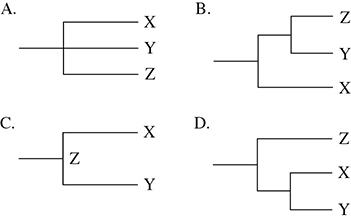AP Biology Practice Exam 1: Section I
MULTIPLE-CHOICE QUESTIONS
Time—1 hour and 30 minutes
For the multiple-choice questions that follow, select the best answer and fill in the appropriate letter on the answer sheet.
1. Which of the following characteristics would allow you to distinguish a prokaryotic cell from an animal cell?
A. Ribosomes
B. Cell membrane
C. Chloroplasts
D. Cell wall
2. Which of the following is the source of oxygen produced during photosynthesis?
A. H2O
B. H2O2
C. CO2
D. CO
3. An organism exposed to wild temperature fluctuations shows very little, if any, change in its metabolic rate. This organism is most probably a(n)
A. ectotherm.
B. endotherm.
C. thermophyle.
D. ascospore.
4. Which of the following is a frameshift mutation?
A. CAT HAS HIS → CAT HAS HIT
B. CAT HAS HIS → CAT HSH ISA
C. CAT HAS HIS → CAT HIS HAT
D. CAT HAS HIS → CAT WAS HIT
5. A researcher conducts a survey of a biome and finds 35 percent more species than she has found in any other biome. Which biome is she most likely to be in?
A. Tundra
B. Tiaga
C. Tropical rainforest
D. Temperate deciduous forest
6. On the basis of the following crossover frequencies, determine the relative location of these four genes:
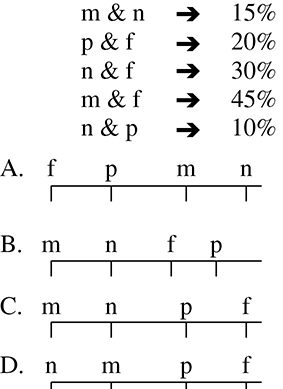
7. A man contracts the same flu strain for the second time in a single winter season. The second time he experiences fewer symptoms and recovers more quickly. Which cells are responsible for this rapid recovery?
A. Helper T cells
B. Cytotoxic T cells
C. Memory cells
D. Plasma cells
8. Which of the following are traits that are affected by more than one gene?
A. Heterozygous traits
B. Pleiotropic traits
C. Polygenic traits
D. Blended alleles
9. A lizard lacking a chemical defense mechanism that is colored in the same way as a lizard that has a defense mechanism is displaying
A. aposometric coloration.
B. cryptic coloration.
C. Batesian mimicry.
D. Müllerian mimicry.
10. Crossover would most likely occur in which situation?
A. Two genes (1 and 2) are located right next to each other on chromosome A.
B. Gene 1 is located on chromosome A, and gene 2 is on chromosome B.
C. Genes 1 and 2 are located near each other on the X chromosome.
D. Gene 1 is located on chromosome A; gene 2 is located far away, but on the same chromosome.
11. Imagine an organism whose 2n = 96. Meiosis would leave this organism’s cells with how many chromosomes?
A. 192
B. 96
C. 48
D. 24
12. A student conducts an experiment to test the efficiency of a certain enzyme. Which of the following protocols would probably not result in a change in the enzyme’s efficiency?
A. Bringing the temperature of the experimental setup from 20°C to 50°C
B. Adding an acidic solution to the setup
C. Adding substrate but not enzyme
D. Placing the substrate and enzyme in a container with double the capacity
13. You observe a species that gives birth to only one offspring at a time and has a relatively long life-span for its body size. Which of the following is probably also true of this organism?
A. It lives in a newly colonized habitat.
B. It is an aquatic organism.
C. It requires relatively high parental care of offspring.
D. The age at which the offspring themselves can give birth is relatively young.
14. In a certain species of plant, the allele to produce green melons (G) is dominant over the allele to produce yellow melons (g). A student performed a cross between a plant that produced green melons and a plant that produced yellow melons. When the student observed the next generation, the 94 seeds that were produced from the cross matured into 53 plants with green melons and 41 plants with yellow melons. Calculate the chi-squared value for the null hypothesis that the green-melon parent was heterozygous for the melon-color gene.
A. 0.76
B. 1.53
C. 0.50
D. 1.26
15. In a certain population of squirrels that is in Hardy-Weinberg equilibrium, black color is a recessive phenotype present in 9 percent of the squirrels, and 91 percent are gray. What percentage of the population is homozygous dominant for this trait?
A. 21 percent
B. 30 percent
C. 49 percent
D. 70 percent
16. Refer to question 15 for details on the squirrel population. Which of the following conditions is required to keep this population in Hardy- Weinberg equilibrium?
A. Random mating
B. Genetic drift
C. Mutation
D. Gene flow
17. A reaction that includes energy as one of its reactants is called a(n)
A. exergonic reaction.
B. hydrolysis reaction.
C. endergonic reaction.
D. redox reaction.
18. To which of the following labeled trophic levels would an herbivore most likely be assigned?
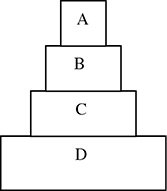
A. A
B. B
C. C
D. D
19. A population undergoes a shift in which those who are really tall and those who are really short decrease in relative frequency compared to those of medium size, due to a change in the availability of resources. This is an example of
A. directional selection.
B. stabilizing selection.
C. disruptive selection.
D. sympatric speciation.
20. Which of the following statements is correct?
A. Water flows from hypertonic to hypotonic.
B. Germinating seeds use less oxygen than do nongerminating seeds.
C. The rate of transpiration decreases with an increase in air movement.
D. Smaller DNA fragments migrate more rapidly than do larger DNA fragments on gel electrophoresis.
21. Which of the following is not a form of interspecies interaction?
A. Commensalism
B. Succession
C. Mutualism
D. Parasitism
22. Sickle cell anemia is a disease caused by the substitution of an incorrect nucleotide into the DNA sequence for a particular gene. The amino acids are still added to the growing protein chain, but the symptoms of sickle cell anemia result. This is an example of a
A. frameshift mutation.
B. missense mutation.
C. nonsense mutation.
D. thymine dimer mutation.
23. In a population of grasshoppers, the allele for tan color is dominant to the allele for green color. A drastic increase in rainfall leads to selection against the tan phenotype. When the rainy season ends, 23 percent of the remaining grasshoppers have the green phenotype. If this population is now in Hardy-Weinberg equilibrium, what will the frequency of the tan allele be in the next generation?
A. 0.52
B. 0.48
C. 0.23
D. 0.071
24. This process couples the production of ATP with the movement of electrons down the electron transport chain by harnessing the driving force created by a proton gradient.
A. Glycolysis
B. Chemiosmosis
C. Fermentation
D. Calvin cycle
25. During prophase 1 of meiosis, homologous chromosomes come together during a synapsis to form a tetrad. What does this lead to?
A. Leads to genetic variation via crossing over
B. Ensures that four daughter cells are produced
C. Creates male and female gametes
D. Separation of sister chromatids
26. The bacteria that cause pimples can be grown in the lab using a suitable nutrient broth, where they will eventually achieve exponential growth. Using the graph that follows, calculate the mean rate of growth, in millions of bacteria per hour, during their exponential phase.
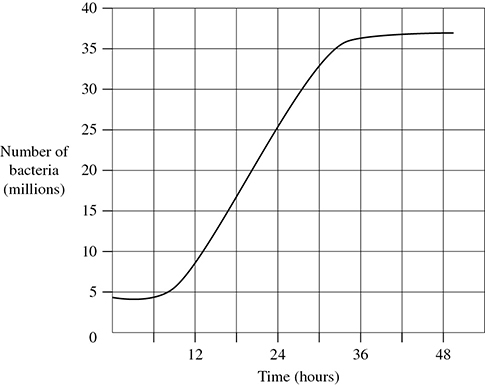
A. 1.46
B. 1.27
C. 0.83
D. 0.89
27. In a large pond consisting of long-finned fish and short-finned fish, a dam is built, splitting the large pond into two separate ponds. Fifty percent of the fish population is randomly separated into each of the smaller ponds leading to two distinct populations of long-finned and short-finned fish. This is an example of:
A. Gene flow
B. Bottleneck
C. Founder effect
D. Allopatric speciation
28. What is the water potation for a solution that is 0.1 M at 20°C? The solution is an open container of
A. -2.4.
B. 2.4.
C. -1.4.
D. 1.4.
For questions 29–30, please refer to the following answers:
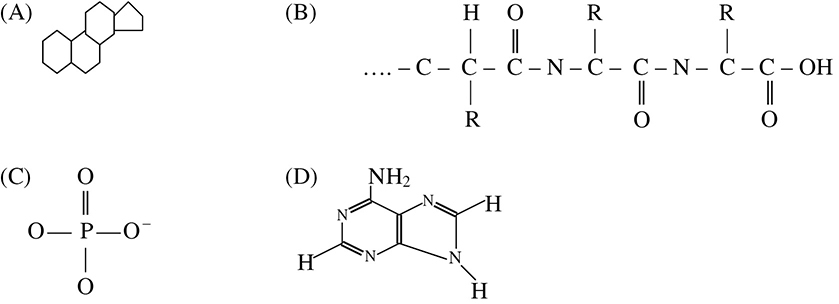
29. The specific order of which of the above -molecules is responsible for the primary structure of proteins?
30. Which molecule is the backbone of a structure that is vital to the construction of many cells and is used to produce steroid hormones?
31. A cell, shaped like a cube, contains sides with a measurement of 2.5 cm. Determine the surface- area-to-volume ratio for the cell.
A. 15.6
B. 2.4
C. 37.5
D. 5.2
Questions 32–34: A behavioral endocrinologist captures male individuals of a territorial bird species over the course of a year to measure testosterone (T) levels. In this population, males may play one of two roles: (1) they may stay in their natal group (the group they were born in) and help raise their younger siblings, or (2) they may leave the natal group to establish a new territory. Use this information and the two histograms that follow to answer the following questions.
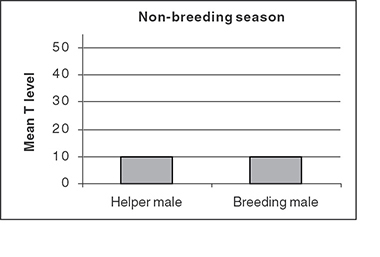
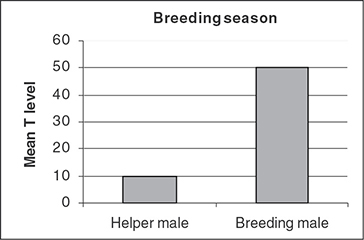
32. Testosterone level in this population may be an example of
A. adaptive radiation.
B. an adaptation.
C. divergent selection.
D. development.
33. What can you infer about the role of testosterone in reproduction in this species?
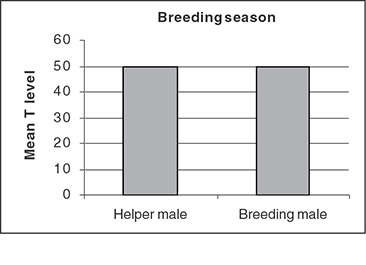
A. It is detrimental to breeding.
B. It aids adult males only.
C. It ensures that all males reproduce equally.
D. It aids in breeding.
34. Which of the following is the best explanation of the results presented in the preceding graph, collected from the same population in a different year?
A. The so-called helper males are actually breeding.
B. The population has stopped growing.
C. Females are equally attracted to adult and helper males.
D. Testosterone level is affected by many processes.
Questions 35–38: A researcher grows a population of ferns in her laboratory. She notices, after a few generations, a new variant that has a distinct phenotype. When she tries to breed the original phenotype with the new one, no offspring are produced. When she breeds the new variants, however, offspring that look like the new variant result.
35. What originally caused the change in the variant?
A. Karyotyping
B. Balance polymorphism
C. Mutation
D. Polyploidy
36. What kind of speciation does this example illustrate?
A. Allopatric
B. Sympatric
C. Isolated
D. Polyploidy
37. Which of the following could possibly characterize the new variant?
A. Adaptive radiation
B. Divergent selection
C. Equilibrium
D. Polyploidy
38. Which of the following is likely to exhibit the process described earlier?
A. Fallow deer
B. Fruit flies
C. Grass
D. Spotted toads
For questions 39–41, please refer to the following figure:
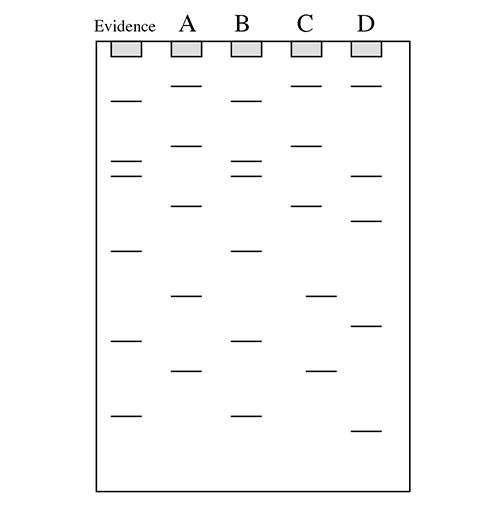
39. The DNA placed in this electrophoresis gel separates as a result of what characteristic?
A. pH
B. Charge
C. Size
D. Polarity
40. If this gel were used in a court case as DNA evidence taken from the crime scene, which of the following suspects appears to be guilty?
A. Suspect A
B. Suspect B
C. Suspect C
D. Suspect D
41. Which two suspects, while not guilty, could possibly be identical twins?
A. A and B
B. A and C
C. B and C
D. B and D
Questions 42–45: The frequency of genotypes for a given trait are given in the accompanying graph. Answer the following questions using this information:

42. What is the frequency of the recessive homo-zygote?
A. 15 percent
B. 19 percent
C. 25 percent
D. 40 percent
43. What would be the approximate frequency of the heterozygote condition if this population were in Hardy-Weinberg equilibrium?
A. 20 percent
B. 45 percent
C. 48 percent
D. 72 percent
44. Is this population in Hardy-Weinberg equilibrium?
A. Yes
B. No
C. Cannot tell from the information given
D. Maybe, if individuals are migrating
45. Which of the following processes may be occurring in this population, given the allele frequencies?
A. Directional selection
B. Homozygous advantage
C. Hybrid vigor
D. Allopatric speciation
Questions 46–48: An eager AP Biology student interested in studying osmosis and the movement of water in solutions took a dialysis bag containing a 0.5 M solution and placed it into a beaker containing a 0.6 M solution.
46. After the bag has been sitting in the beaker for a while, what would you expect to have happened to the bag?
A. There will have been a net flow of water out of the bag, causing it to decrease in size.
B. There will have been a net flow of water into the bag, causing it to swell in size.
C. The bag will be the exact same size because no water will have moved at all.
D. The solute will have moved out of the dialysis bag into the beaker.
47. If this bag were instead placed into a beaker of distilled water, what would be the expected result?
A. There will be a net flow of water out of the bag, causing it to decrease in size.
B. There will be a net flow of water into the bag, causing it to swell in size.
C. The bag will remain the exact same size because no water will move at all.
D. The solute will flow out of the dialysis bag into the beaker.
48. Which of the following is true about water potential?
A. It drives the movement of water from a region of lower water potential to a region of higher water potential.
B. Solute potential is the only factor that determines the water potential.
C. Pressure potential combines with solute potential to determine the water potential.
D. Water potential always drives water from an area of lower pressure potential to an area of higher pressure potential.
Questions 49–51 all use the following pedigree, but are independent of each other:
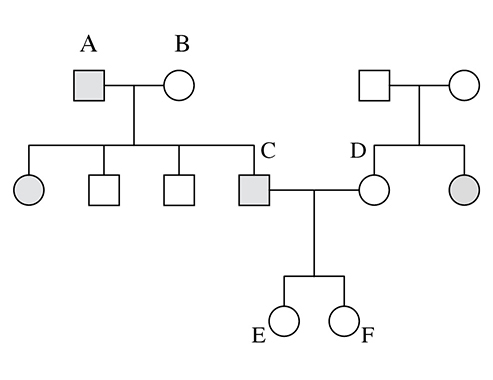
49. If the pedigree is studying an autosomal recessive condition for which the alleles are A and a, what was the probability that a child produced by parents A and B would be hetero-zygous?
A. 0.0625
B. 0.1250
C. 0.2500
D. 0.5000
50. Imagine that a couple (C and D) goes to a genetic counselor because they are interested in having children. They tell the counselor that they have a family history of a certain disorder and they want to know the probability of their firstborn having this condition. What is the probability of the child having the autosomal recessive condition?
A. 0.0625
B. 0.1250
C. 0.2500
D. 0.3333
51. Imagine that a couple (C and D) has a child (E) that has the autosomal recessive condition being traced by the pedigree. What is the probability that their second child (F) will have the autosomal recessive condition?
A. 0.0625
B. 0.1250
C. 0.2500
D. 0.5000
For questions 52–53, please refer to the following diagram:
52. The bold line that point C intersects is known as the
A. biotic potential.
B. carrying capacity.
C. limiting factor.
D. maximum attainable population.
53. On the basis of what happens at the end of this chart, what is the most likely explanation for the population decline after point E?
A. The population became too dense and it had to decline.
B. There was a major environmental shift that made survival impossible for many.
C. Food became scarce, leading to a major famine.
D. The population had become too large.
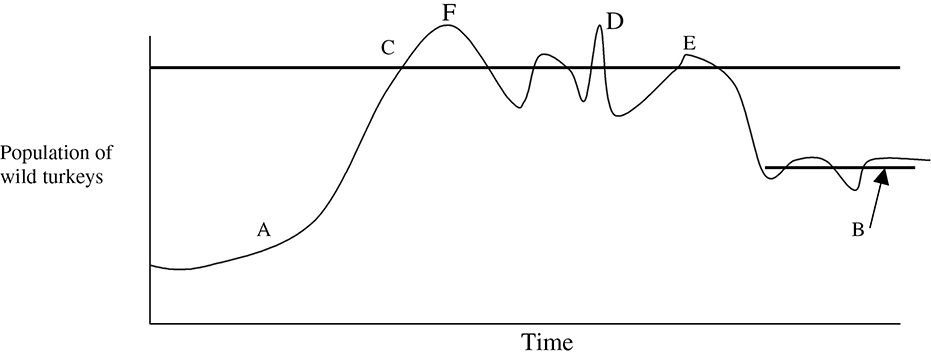
Questions 54 and 55: The solutions in the two arms of this U-tube are separated by a membrane that is permeable to water and sodium chloride, but not to sucrose. Side A is filled with a solution of 0.6 M sucrose and 0.2 M sodium chloride (NaCl), and side B is filled with a solution of 0.2 M sucrose and 0.3 M NaCl. Initially, the volume on both sides is the same.
54. At the beginning of the experiment,
A. side A is hypertonic to side B.
B. side A is hypotonic to side B.
C. side A is isotonic to side B.
D. side A is hypotonic to side B with respect to sucrose.
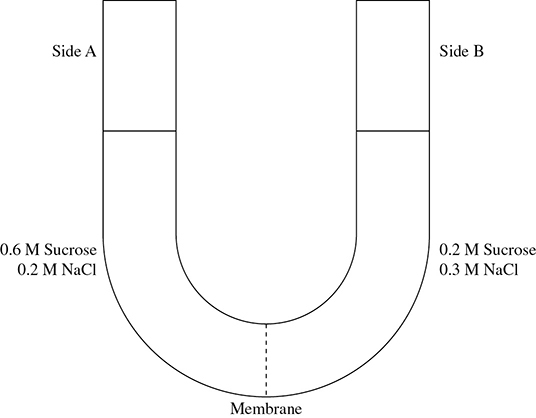
55. If you examine side A after a couple of days, you will see
A. an increase in the concentration of NaCl and sucrose and an increase in water level.
B. a decrease in the concentration of NaCl, an increase in water level, and no change in the concentration of sucrose.
C. no net change.
D. an increase in the concentration of NaCl and an increase in the water level.
56. Tay-Sachs is a disease caused by a recessive allele. Individuals with the genetic disorder usually do not survive more than a few years, and thus are not able to reproduce and pass on the gene. What would explain how this allele and its associated disease is preserved in the population?
A. Heterozygous individuals will show no symptoms.
B. Spontaneous mutation converts the dominant allele to the recessive form.
C. Occasionally the gene will instead increase the fitness of the individual.
D. Tay-Sachs is asymptomatic in people who are homozygous recessive.
57. A new plant was discovered and determined to have an unusually low number of stomata on the undersides of its leaves. For what environment would this plant most likely be best adapted?
A. Cold and rainy
B. Humid and sunny
C. Hot and humid
D. Hot and dry
58. The first simple cells evolved approximately 3.5 billion years ago, followed by the more complex eukaryotic cells 2.1 billion years ago. Which of the following statements is correct?
A. Eukaryotic organelles helped create separate environments for metabolic reactions, thus increasing their metabolic efficiency.
B. Prokaryotic and eukaryotic cells have no structural similarities.
C. The organelles in larger eukaryotic cells took care of the problems of having a larger surface-area-to-volume ratio.
D. Eukaryotic cells are able to multiply faster based on their more complex structure.
59. Easily produced genetic variation is key to the rapid evolution of viral and microbial populations. Furthermore, pathogens that need to escape the immune system rely on this variation to generate new surface antigens that go unrecognized by the host’s immune system. Which of the following is an example of this antigenic variation?
A. HIV, which can remain integrated into the host genome for many years
B. The flu virus, which changes its envelope proteins
C. MRSA, which has become resistant to many antibiotics
D. Multiple sclerosis, which attacks the cells of the nervous system
60. Two species of hamster (X and Y) are in the genus Cricetulus, whereas a third species (Z) is instead part of genus Mesocricetus. Which of the following phylogenetic trees shows the correct evolutionary relatedness?
